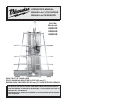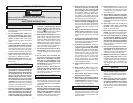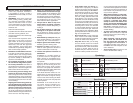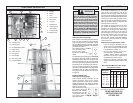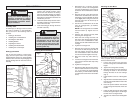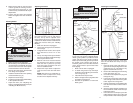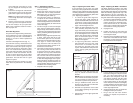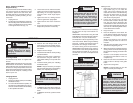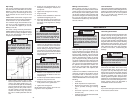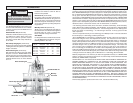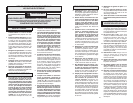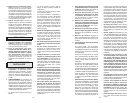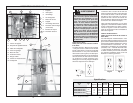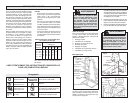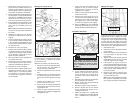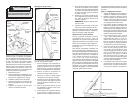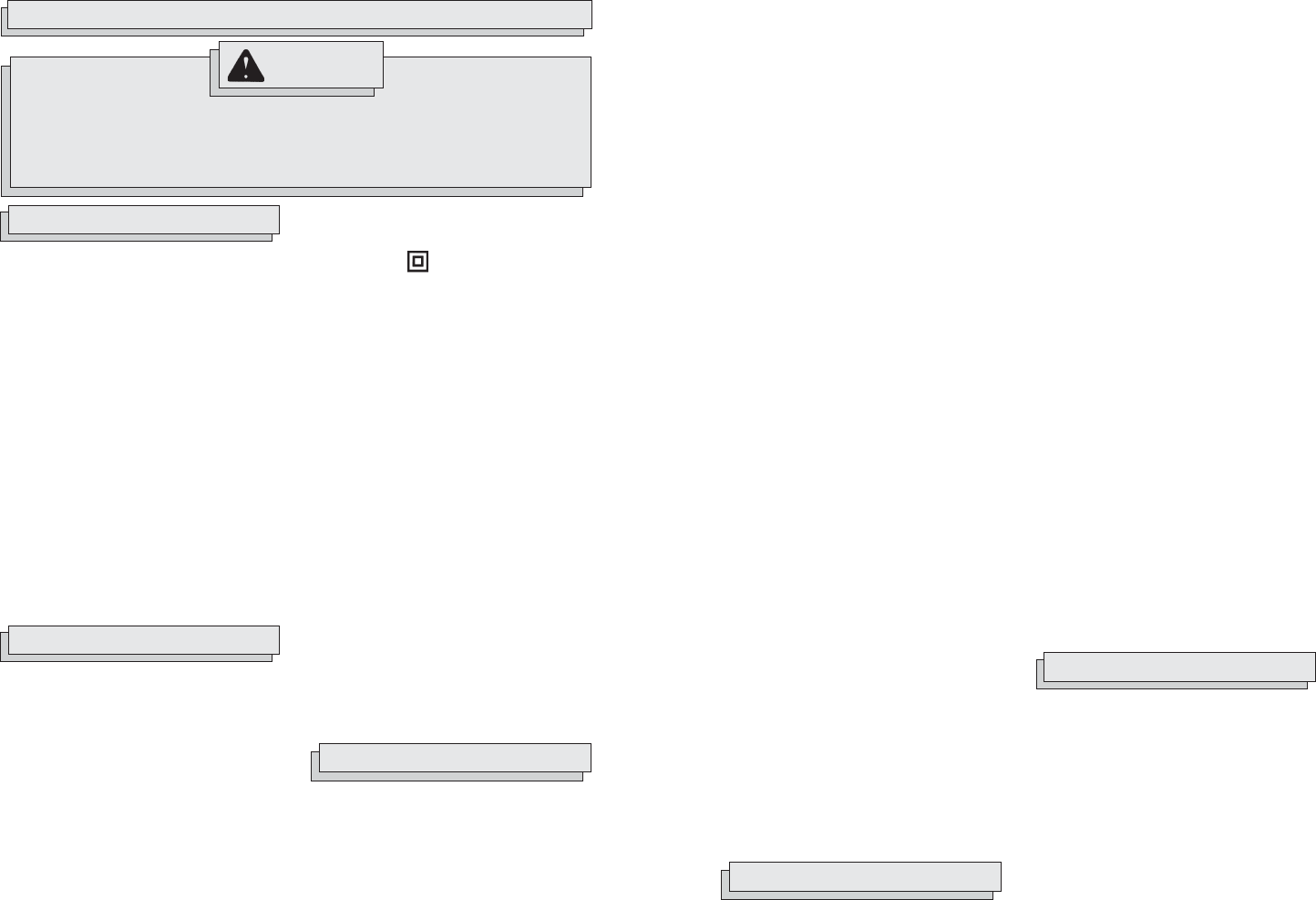
2 3
WORK AREA SAFETY
ELECTRICAL SAFETY
PERSONAL SAFETY
WARNING
READ ALL INSTRUCTIONS
Failure to follow all instructions listed below, may result in electric shock, fi re
and/or serious personal injury.
SAVE THESE INSTRUCTIONS
GENERAL SAFETY RULES
6. Grounded tools must be plugged
into an outlet properly installed and
grounded in accordance with all
codes and ordinances. Never remove
the grounding prong or modify the
plug in any way. Do not use any
adaptor plugs. Check with a quali-
fi ed electrician if you are in doubt
as to whether the outlet is properly
grounded. If the tools should electrically
malfunction or break down, grounding
provides a low resistance path to carry
electricity away from the user.
7. Double Insulated tools are equipped
with a polarized plug (one blade is
wider than the other). This plug will
fi t in a polarized outlet only one way.
If the plug does not fi t fully in the
outlet, reverse the plug. If it still does
12. Know your power tool. Read this
manual carefully to learn your power
tool's applications and limitations as well
as potential hazards associated with this
type of tool.
13. Stay alert, watch what you are doing,
and use common sense when operat-
ing a power tool. Do not use tool while
tired or under the infl uence of drugs,
alcohol, or medication. A moment of
inattention while operating power tools
may result in serious personal injury.
14. Dress properly. Do not wear loose
clothing or jewelry. Contain long
hair. Keep your hair, clothing, and
gloves away from moving parts.
Loose clothes, jewelry, or long hair can
be caught in moving parts. When work-
ing outdoors, wear rubber gloves and
insulated non-skid footwear. Keep hands
and gloves away from moving parts.
15. Avoid accidental starting. Be sure
switch is off before plugging in. Do
not use a tool if the power switch does
not turn the tool on and off. Do not carry
a plugged-in tool with your fi nger on the
switch.
16. Remove adjusting keys or wrenches
before turning on the tool. A wrench
or a key that is left attached to a rotating
part of the tool may result in personal
injury.
17. Do not overreach. Keep proper footing
and balance at all times. Proper footing
and balance enables better control of the
tool in unexpected situations.
18. Use safety equipment. Everyone
in the work area should wear safety
goggles or glasses with side shields
complying with current safety standards.
Everyday eyeglasses only have impact
resistant lenses. They are not safety
glasses. Wear hearing protection dur-
ing extended use and a dust mask
for dusty operations. Hard hats, face
shields, safety shoes, etc., should be
used when specifi ed or necessary. Keep
a fi re extinguisher nearby.
19. Keep guards in place and in working
order.
20. Never stand on tool. Serious injury
could occur if the tool is tipped or if
the cutting tool is unintentionally con-
tacted.
21. Keep hands away from all cutting
edges and moving parts.
22. Use clamps or other practical way to
secure and support the workpiece to
a stable platform. Holding the work by
hand or against your body is unstable
and may lead to loss of control.
24. Use the right tool. Do not use a tool or
attachment to do a job for which it is not
recommended. For example, do not use
a circular saw to cut tree limbs or logs.
Do not alter a tool.
25. Disconnect the plug from the power
source before making any adjust-
ments, changing accessories, or stor-
ing the tool. Such preventive safety mea-
sures reduce the risk of starting the tool
accidentally.
26. Store idle tools out of reach of
children and other untrained
persons. Tools are dangerous in the
hands of untrained users.
27. Never leave the tool running unat-
tended. Turn power off. Do not leave the
tool until it comes to a complete stop.
28. Check for misalignment or binding
of moving parts, breakage of parts,
and any other condition that may af-
fect the tool’s operation. If damaged,
have the tool serviced before using.
Many accidents are caused by poorly
maintained tools.
29. Use only accessories that are rec-
ommended by the manufacturer for
your model. Accessories that may be
suitable for one tool, may become haz-
ardous when used on another tool.
30. Maintain tools with care. Keep cut-
ting tools sharp and clean. Properly
maintained tools with sharp cutting edge
are less likely to bind and are easier to
control. Do not use a damaged tool.
Tag damaged tools “Do not use” until
repaired.
1. Keep your work area clean and well
lit. Cluttered benches and dark areas
invite accidents.
2. Do not operate power tools in ex-
plosive atmospheres, such as in
the presence of fl ammable liquids,
gases, or dust. Power tools create
sparks which may ignite the dust or
fumes.
3. Keep bystanders, children, and
visitors away while operating a power
tool. Distractions can cause you to lose
control. Protect others in the work area
from debris such as chips and sparks.
Provide barriers or shields as needed.
4. Protect others in the work area from
debris such as chips and sparks. Pro-
vide barriers or shields as needed.
5. Make workshop child proof with pad-
locks, master switches, or by removing
starter keys.
not fi t, contact a qualifi ed electrician
to install a polarized outlet. Do not
change the plug in any way. Double
insulation eliminates the need for
the three wire grounded power cord and
grounded power supply system.
8. Guard against electric shock. Prevent
body contact with grounded surfaces
such as pipes, radiators, ranges and re-
frigerators. When making blind or plunge
cuts, always check the work area for
hidden wires or pipes. Hold your tool by
insulated nonmetal grasping surfaces.
Use a Ground Fault Circuit Interrupter
(GFCI) to reduce shock hazards.
9. Do not expose power tools to rain or
wet conditions. Water entering a power
tool will increase the risk of electric
shock.
10. Do not abuse the cord. Never use
the cord to carry the tools or pull the
plug from an outlet. Keep cord away
from heat, oil, sharp edges or mov-
ing parts. Replace damaged cords
immediately. Damaged cords increase
the risk of electric shock.
11. When operating a power tool out-
side, use an outdoor extension cord
marked “W-A” or “W”. These cords
are rated for outdoor use and reduce
the risk of electric shock.
TOOL USE AND CARE
23. Do not force tool. Your tool will per-
form best at the rate for which it was
designed. Excessive force only causes
operator fatigue, increased wear and
reduced control.
SERVICE
31. Tool service must be performed
only by qualifi ed repair personnel.
Service or maintenance performed by
unqualifi ed personnel could result in a
risk of injury.
32. When servicing a tool, use only iden-
tical replacement parts. Follow in-
structions in the Maintenance section
of this manual. Use of unauthorized
parts or failure to follow Maintenance
Instructions may create a risk of electric
shock or injury.



